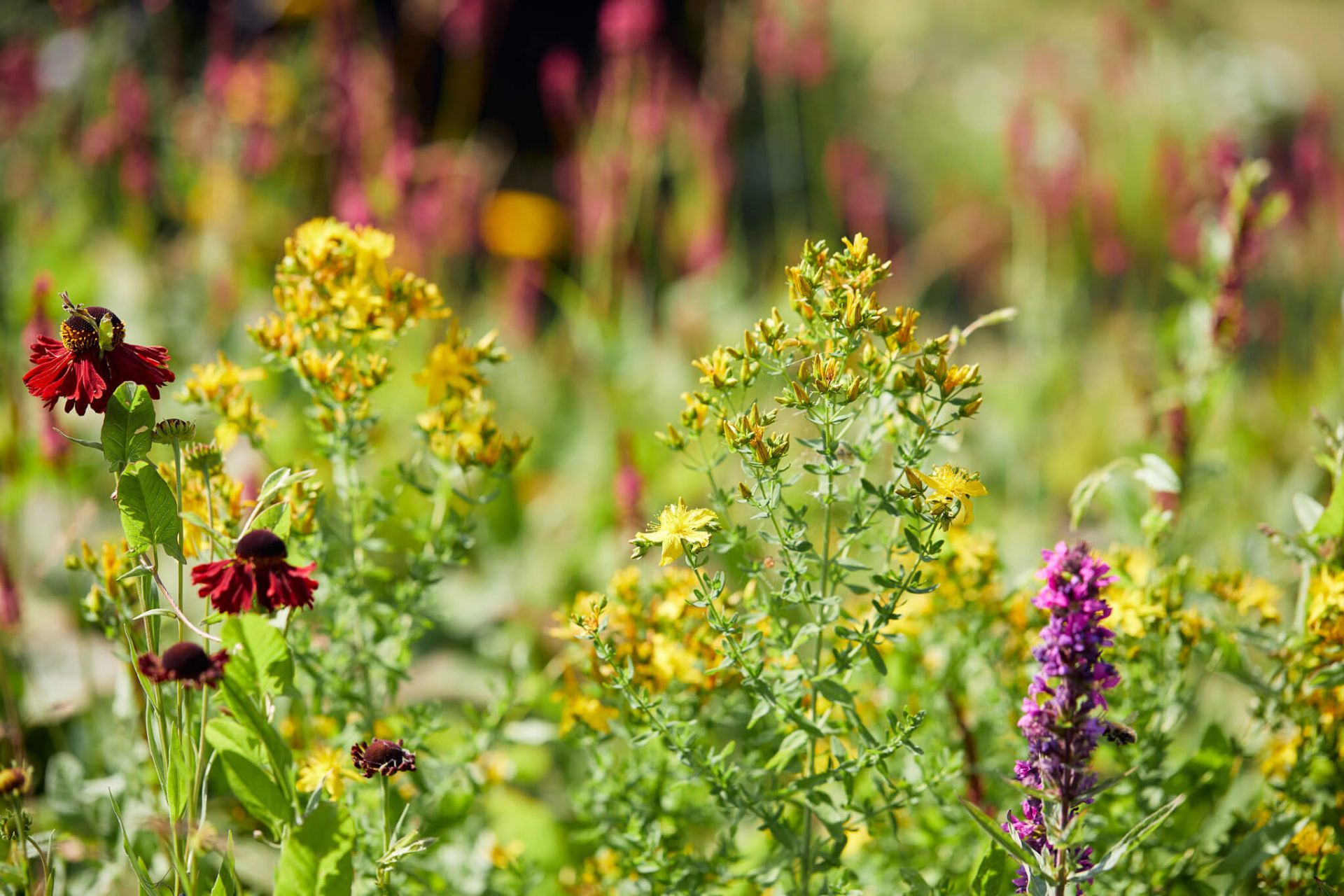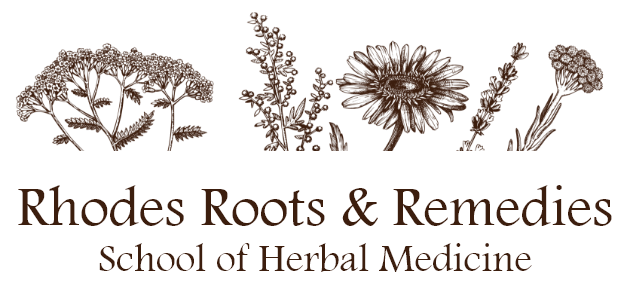As the original medicine, herbal medicine spans all cultures, continents and civilisations. We are fortunate so many of these ancient lines of observing the natural world - both plants and people - are intact today and that we are able to explore and consider so many valuable perspectives that contribute to our better understanding of how all of nature can thrive together. Each practising herbalist finds their own inspiration and creates their own alchemy, and you will, too. On our herbal courses, you will have the opportunity to explore the energetics, concepts and terminology of both Western herbal medicine and Ayurvedic perspectives, intimately woven together in a way that facilitates embodied, elemental and experiential learning. Here’s more of a look into each and how we weave them into your learning journey.

1. How We Work With Western Herbalism Concepts on Our Herbal Courses
The sets of twelve herbs we get to know each of the three years of our herbal courses are predominantly local to the UK and have long been part of Western herbal medicine practices, although we do weave a few Ayurvedic herbs into the mix as the years progress. In getting to know these herbs, we go through the gateway of two key Western herbal practices - organoleptics (understanding a herb’s medicinal properties through the senses of taste and smell) and the Doctrine of Signatures (the ancient approach of using sight and touch to discern affinities different plants have to specific parts of the body).
Although many forms of herbal remedies are shared across different cultural and energetic herbal traditions, our herbal courses focus on the ones we most commonly work with in Western herbalism - tinctures, teas, salves, creams, body butters, herb infused oils, vinegars, elixirs, electuaries, poultices and salts. Some Ayurvedic preparations, like an arista - a fermented herbal infusion prepared with a specific process - are incredible medicine, but not ones we’ll be exploring on our herbal courses.
We also work heavily with the qualities of Western herbal medicine - namely temperature, moisture and tone. These give us a powerful gauge to navigate the balance we need to restore in the body, as Western herbal medicine works with the core concept of using opposites to create balance. Thus, if someone has too much heat in the body (e.g. inflammation), we balance with cooling herbs. If someone has too much moisture (e.g. mucous and phlegm), we balance with drying herbs. If someone has excess tension and constriction in their body (e.g. constricted blood vessels in the fingers, resulting in cold, painful hands), we balance with relaxing herbs.
There are many other layers to the energetics of Western herbalism, such as whether a herb is heating in the first, second, third or fourth degree, but this can often be quite challenging to grasp and remember, as they’re not as straightforward as they seem (e.g. heating in the fourth degree doesn’t mean it’s the hottest in terms of temperature), or the four Western constitutions of choleric, phlegmatic, melancholic or sanguine. This is why we weave in the elements and constitutions from an Ayurvedic perspective on our herbal courses.
2. How We Work With Ayurvedic Concepts on Our Herbal Courses
Our intention in weaving Ayurvedic concepts and energetics into our herbal courses is to keep herbal learning as practical and tangible as possible. Ayurveda is its own herbal medicine practice and system with thousands of years of history behind it, originating from the Indian subcontinent. One could easily study Ayurveda for a lifetime - indeed, its name means ‘knowledge of life’.
What we pull into our herbal courses is a focus on looking at the elements within the body, the ways in which they tend to combine into constitutions (the doshas) and the ways in which they interact within the body to create balance or imbalance. As we progress to the second and third years of the course, we look at the tissues and pathways in the body from an Ayurvedic perspective, but the focus is never on memorising huge lists of Sanskrit terminology. We tend to keep things to the names of the three doshas (vata, pitta, kapha - all of which are taught on our herbal courses), the name for toxins in the body (ama) and the digestive fire (agni - which goes far beyond just digestion, but we start there and build in more detail and nuance as we go). You don’t need any previous knowledge of Ayurveda to understand these concepts - although we have had students who have some background in Ayurveda who have thoroughly enjoyed our herbal courses. It’s all elemental, which means we can break down what’s going on in someone’s body into the dynamics of the elements.
The reason we do this is twofold: 1 - It means we are focusing on observing and listening and understanding, rather than trying to attach a label of a diagnosis or condition to someone. 2 - It means whether someone has been given a diagnosis and you’re not overly familiar with it or someone has not been given a diagnosis, you can still support them effectively because you are focusing on the dynamics of their body in that given moment and you can track those changes and adjust your herbal remedies as their needs change. Working with Ayurvedic energetics on our herbal courses means we make what could be overly theoretical or medical or complicated real, accessible and actionable.
3. How We Blend the Two
Here’s what this looks like in practice.
Each week in the spring/summer sessions, we focus on getting to know one herb per week. We all make the tea of that herb for our live session and we sit together online and sip. What tastes does this herb have? We consider both Western herbalism and Ayurvedic tastes, including when their perspectives may vary on the same flavour. What qualities does it have? Is it warming or cooling, moistening or drying, tightening or relaxing? How does this herb influence the doshas in the body? Is it increasing, decreasing or balancing vata, pitta, kapha? What seasons of the year is this herb at its peak? In which seasons is it most suitable to work with? Where do we feel this herb gravitating in the body - what affinities does it have for an organ, system or area of the body? (In the second year, we include the Ayurvedic tissues and channels.) We then go on to discuss the forms of herbal remedies that best suit that plant - what makes it really sing? - as well as safety. Finally, we look at the classic Western herbal actions of the plant to get our herbal reference shorthand down, helping us in the future if we ever want to cross-check something we’re putting together.
Each week in the autumn/winter sessions, we turn our focus to our bodies. In the first year, we explore common conditions we would want to support in the home, e.g. fever, digestive upsets, inflammation, sleep, anxiety, etc. We look at the pathogenesis (progression of disease), working through the six stages of disease from an Ayurvedic perspective, creating branching if/then charts to see how things are likely to begin and how they could end up if allowed to progress for long periods of time. We explore what that common condition might look or feel like in its vata form, pitta form or kapha form, helping us further hone our skills of understanding what’s happening for someone and then being able to combine herbs for the most effective support possible. We revisit the tastes of the herbs we’d want to include in a remedy and whether we need to balance excess heat or insufficient moisture or release too much tightness, for example. Then we look at our connected Western herbal actions and take a few more parts of the picture into consideration before we start to think about a potential blend of herbs for support.
If you like the sound of how we weave together Western herbalism and Ayurveda on our herbal courses, you’re very welcome to take the next step on your journey building your knowledge, skills and confidence as a home herbalist with us on our intensive herbalism course - Awaken Herbal Wisdom - which spans all four seasons and gets herbalism both deep into your bones and your daily life. Although it is intense, it’s suitable for a wide range of herbalists, including beginners! You can learn more about our herbal medicine course here. Be sure to put your name on the waiting list to see what the current cohorts are up to and get first access to enrolment before it opens.
However many turnings of the wheel you choose to join us on our herbal courses, I’m sure you will enjoy the journey!
At Rhodes Roots & Remedies School of Herbal Medicine, our practice of herbalism is rooted in the belief that we must remember, reclaim and relearn our knowledge of our bodies, our autonomy and how to work with plant medicine in order to bring control of our own health back into our families and homes for a sustainable future for ourselves and the planet. Through our intensive herbalism course, we facilitate the development of confident, empowered herbalists, attuned to the messages of their bodies and the natural world. Living the deep wisdom of herbal medicine within themselves, their homes and their communities, they uplift themselves and others, creating a stronger society organically. We do hope you'll join us on your journey!

